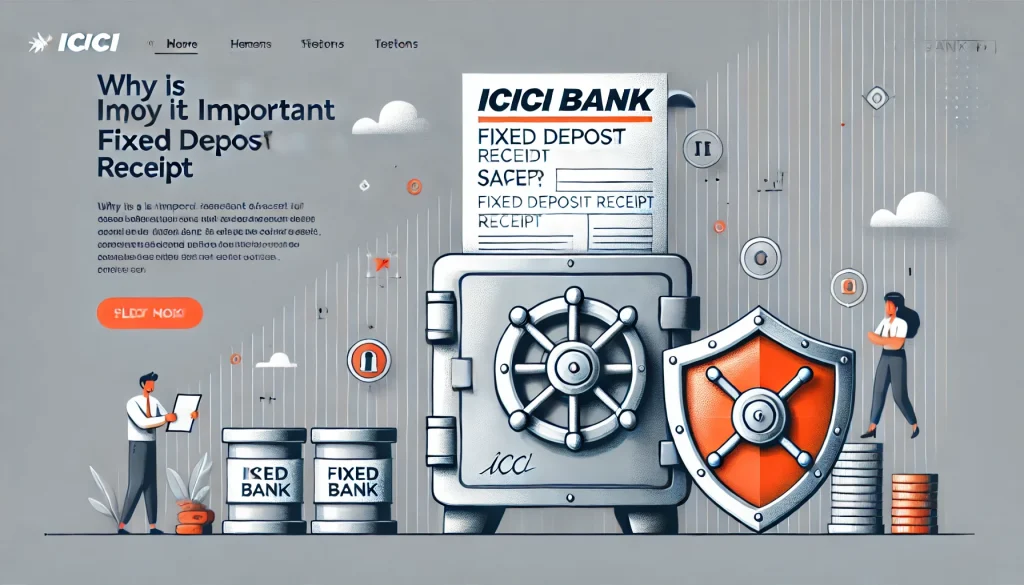
Fixed deposit is a popular investment option among risk-averse individuals, allowing them to grow their savings. It is an ideal financial instrument to achieve long-term or short-term goals for anyone seeking recommendations. Let’s explore and discuss the fixed deposit account, interest rates, and other relevant details that investors need to know before including it in their investment portfolio.
What is a Fixed Deposit Account?
Before we dive into a detailed guide to the FD account, let’s first find out what the FD full form is. FD stands for Fixed Deposit, a term deposit that allows depositors to invest a lump sum amount for a predetermined period and earn high-yielding interests in return.
A fixed deposit account is a better alternative to a savings account. In a fixed deposit account, an individual or an entity can park their idle funds so as to generate steady returns. A bank, post office, or financial institution can easily open such an account.
How Does Fixed Deposit Work?
Now that you know what is a fixed deposit account, let’s understand how it works. Simply put, a fixed deposit works on a concept where an individual deposits a sum of money in a bank or financial institution for a predetermined tenure while earning a fixed interest in return. Moreover, an FD account works on the basis of terms and conditions associated with a scheme.
Banks generally utilise the investment made in an FD scheme to lend funds to borrowers from whom they charge interest.
Features of Fixed Deposit
Take a look at some of the salient features that define fixed deposits and distinguish them from other available investment options.
1. Guaranteed Income Plan
As its name suggests, an FD is a fixed-income securities that offers guaranteed returns to the depositors, regardless of any interest fluctuations in the market. Through this scheme, an investor can receive the exact estimate of income as per the applicable interest rate that is predetermined at the time of FD account opening.
2. Flexible Tenure
A fixed deposit scheme offers flexibility to all depositors/investors to choose a tenure that suits their liquidity requirements and financial planning. Generally, most banks and financial institutions have an FD tenure of between 7 days to 10 years. However, there are some FD schemes with special tenures that provide higher returns than regular FD.
3. Higher Returns
A depositor/investor can avail higher returns than a regular savings account by investing in a fixed deposit scheme. Moreover, most Indian banks provide preferential interest rates to senior citizens, that is, an additional 0.50% interest over regular interest rates.
FD Interest Rates
Here is a list of the top Indian banks offering fixed deposit schemes, along with a breakdown of the interest rates that each provides.
| Bank | General Citizen Rate | Senior Citizen Rate |
|---|---|---|
| State Bank of India | 3.00% to 7.10% | 3.50% to 7.60% |
| ICICI Bank | 3.00% to 7.25% | 3.50% to 7.25% |
| AXIS Bank | 3.00% to 7.25% | 3.50% to 7.75% |
| HDFC Bank | 3.00% to 7.25% | 3.50% to 7.75% |
| Kotak Mahindra Bank | 2.75% to 7.25% | 3.25% to 7.75% |
| IDFC Bank | 3.50% to 7.50% | 4.00% to 8.00% |
| Bank of Baroda | 3.00% to 7.25% | 3.50% to 7.75% |
| Indian Bank | 2.80% to 7.10% | 2.80% to 8.00% |
| IDBI Bank | 3.00% to 6.80% | 3.50% to 7.30% |
| Punjab National Bank | 3.50% to 7.25% | 4.30% to 8.05% |
How is the FD Interest Rate Calculated?
The banks and other financial institutions offering fixed deposit schemes use two mathematical formulas to calculate the interest income earned from FD investments. Let’s find out more about these two formulas and understand their calculation method.
1. Simple Interest
The simple interest formula calculates the amount of interest on the basis of the initial investment made by a depositor, along with the tenure and interest rate. This method of calculating the FD returns payable to a depositor involves the multiplication of the amount of principal investment with the rate of interest and tenure.
Simple Interest = (P * R * T)/100
In this formula,
- P (₹) = Principal Amount or the sum of money invested in an FD scheme
- R (%) = Rate of Interest offered by a bank
- T (years/months/days) = Tenure or time period of an FD scheme
We will now discuss an example to understand its method of calculation. For instance, you want to invest ₹1 lakh in an FD scheme of a bank offering 10% interest for 5 years. Let’s calculate the interest income you will receive from such an investment by using the simple interest method.
Here, the sum of money you will invest or Principal Amount = ₹1,00,000, Rate of Interest = 10% and Tenure = 5 years. By putting these values in the simple interest formula, we will get
Simple Interest = ₹(1,00,000 * 10 * 5) /100 = ₹50,000.
Hence, you will receive an interest income of ₹50,000 by making this investment. With this amount, you can further calculate the maturity value of your FD investment by adding it to your Principal Amount.
Maturity Value = Principal Amount + Simple Interest = ₹(1,00,000 + 50,000) = ₹1,50,000.
2. Compound Interest
The compound interest formula is another way of calculating the amount of interest earned from FD investments. Under this method, interest is calculated based on the principal amount and the previously accumulated amounts of interest using the power of compounding.
A = P (1+r/n) ^ (n * t)
Here,
- A (₹) = Maturity Value of an FD investment
- P (₹) = Principal Amount or the sum of money invested in an FD scheme
- r (decimal or %) = Rate of Interest applicable on a scheme
- n (times) = Number of Compounding in a year
- t (years/months/days) = Tenure or number of years involved in an FD scheme
Let’s understand this formula using an example. Suppose you want to invest an amount of ₹10,000 in another FD scheme for 3 years, with an applicable interest rate of 10%, which is compounded quarterly.
In this case, P = ₹10,000, r = 10%, n = 4 times and t = 3 years.
By putting these values into the formula, we can determine the maturity value of your FD investment and further calculate the interest you will earn.
A = ₹[10,000 {1 + (0.1/4)} ^ (4 * 3)] = ₹13,449.
Now that you know the maturity value, you can calculate the interest by subtracting the principal amount from it.
Compound Interest = Maturity Value – Principal Amount = ₹(13,449 – 10,000) = ₹3,449.
You can also use an online FD Calculator to check the return you will earn by the end of your FD tenure.
Advantages of Investing in FD
Investing in a fixed deposit scheme allows an individual or an entity to avail of the following advantages.
- A fixed deposit scheme offers multiple interest payout options to depositors/investors, allowing them to choose a suitable one as per their financial requirements.
- It provides auto-renewal facilities through which the FD value gets reinvested automatically when it reaches the maturity date of an existing tenure.
- All deposits made in an FD scheme enjoy insurance coverage by the DICGC group of RBI, making it a safe investment option for risk-averse investors.
- By investing in an FD scheme, a taxpayer can claim an exemption under Section 80C of the Income Tax Act and reduce his/her taxable income for a financial year by ₹1,50,000.
- Investment in a fixed deposit involves a simple and instant account opening process involving minimum documentation and deposit amount.
- It also provides additional benefits to depositors such as loan/overdraft against FD and nomination facility.
How to Open an FD Account?
There are two ways of opening an FD account: online and offline. Listed below are the steps that are involved in the two methods.
1. Online
Here is a stepwise process you must follow with due diligence in order to open an FD account online from your preferred device.
- Step 1: Visit the official website or download the mobile app of your preferred bank or financial institution.
- Step 2: Log in with your registered credentials. If you are a new customer, you must create an online account with the bank first.
- Step 3: Find the ‘Fixed Deposit’ option from the main page once you log in to the office website.
- Step 4: Specify all the required details, such as the investment amount, tenure of your FD investment and the nominee details.
- Step 5: Attach all the essential documents and upload them.
- Step 6: After verifying all the details, click on the ‘Confirm’ tab.
- Step 7: Deposit the required amount via the net banking portal.
After a successful payment, the bank will notify you and issue a fixed deposit receipt to you.
2. Offline
The following is a step-by-step guide on how to open an FD account offline.
- Step 1: Visit the nearest branch of your preferred bank or financial institution.
- Step 2: Ask a bank representative for an FD application form.
- Step 3: Fill in the form correctly and specify the desirable tenure and FD investment you want to make.
- Step 4: Attach all the required documents with the application form and submit them to the bank.
- Step 5: Deposit the FD amount in cash/cheque at the counter.
After processing your application form and other details, the bank representative will notify you about the FD account opening.
3. Stable Money App
Stable Money is India’s biggest FD booking platform which allows you to compare FDs from 200+ banks and choose the best FD that suits your goals. Here’s how to book a fixed deposit through the Stable Money app:
- Step 1: Download the Stable Money app from the Play Store and App Store.
- Step 2: Register with your mobile number linked with an Aadhaar Card.
- Step 3: On the Homepage, you will see multiple banks and NBFC FD options. Now, choose the FD you want to book.
- Step 4: Click on Proceed to choose the tenure
- Step 5: Enter the amount, select the tenure, and click Choose & Proceed.
- Step 6: Now, enter your details and do the KYC/v-KYC as required.
- Step 7: Make the payment, and your FD is booked.
Note* – At Stable Money, you can book FD with these banks & NBFCs – Utkarsh Small Finance Bank, Finacare SF Bank, Shriram Finance, Bajaj Finance, South Indian Bank, Shivalik SF, and Axis Bank – coming soon.
Where Can You Open an FD Account?
There are two main financial institutions from where most investors apply for a fixed deposit account. Let’s find out.
1. Bank
A fixed deposit is a common investment product offered by most Indian banks. Generally, a bank FD is designed with a flexible tenure starting from 7 days and extending to 10 years. By investing in a bank FD, senior citizens can avail additional returns over the regular rates payable to general citizens.
2. Post Office
Now that you know what bank fixed deposit is, you can differentiate a post office FD from it. Offering returns between 6.90% and 7.50%, a post office FD has a fixed tenure of 5 years. Although it generally provides higher returns than a bank, there is no additional facility for senior citizens.
Documents Required to Open an FD Account
Here is a list of documents that are required to open an FD account:
- Recent passport-size photographs of the applicant
- Address proof of the applicant as per the KYC norms (Passport, Telephone Bill, Electricity Bill)
- Identity proof of the applicant as per the KYC norms (Aadhaar, Voter TD Card, Driving Licence)
- PAN Card or Form 60/61
Eligibility Criteria for Fixed Deposit Account
The following entities are eligible to open a fixed deposit account.
- Indian Residents
- Non-Resident Indians (NRIs)
- Hindu Undivided Families
- Trusts/Societies/Associations/Clubs
- Partnership Firms
- Sole-proprietorship Businesses
- Public or private companies
- Government Departments/Statutory Board/Local Authority
How to Close an FD Account?
When it comes to closing an FD account, it can be done either online or offline.
1. Online
Here’s how you can close your FD account online.
- Step 1: Visit the official website or download the mobile app of your preferred bank.
- Step 2: Log in to your online account using your registered credentials. You must first sign up for access if you are not registered. You will be redirected to the main page.
- Step 3: Find the ‘Fixed Deposits’ tab from the main dashboard and click on it.
- Step 4: Choose the type of fixed deposit account you operate and want to close.
- Step 5: Click on the ‘Close Account Prematurely’ tab.
- Step 6: On the following page, your FD details, such as the amount of your initial FD investment, tenure and rate of interest, will be displayed. Verify them carefully.
- Step 7: Provide a valid reason for closing your FD account in the ‘Remarks’ box.
- Step 8: Click on the ‘Continue’ tab.
- Step 9: Enter the high-security password sent to your device from the bank and then click on the ‘Confirm’ tab.
Upon successful closure of your FD account, the bank will notify you and credit the FD amount to your linked savings/current account.
2. Offline
The process of offline closure of an FD account involves the following steps.
- Step 1: Visit the nearest branch of your preferred bank.
- Step 2: Obtain a Premature Withdrawal/Closure Form from a bank representative.
- Step 3: Fill in the required details, such as the amount of your FD investment, tenure, applicable rate of interest and the reasons for closure.
- Step 4: Attach all the necessary documents to the form and the fixed deposit receipt and submit them to the bank.
Once your FD account is successfully closed, the bank will notify you and credit the FD amount to your savings/current account.
Final Word
Hopefully, now you have a detailed idea of fixed deposits and their associated factors that can impact your investment portfolio and planning. Although an attractive choice, make sure to verify all the associated terms and conditions before choosing an FD scheme.
FAQs
The minimum deposit requirement amount to open an FD account is ₹1,000. However, it totally depends from bank to bank and NBFCs.
Yes, you can withdraw your FD investment before the maturity date. However, a few banks might charge some penalties for making such withdrawals. The amount of penalty charged generally ranges between 0.5% to 1% of the interest income.
Although the interest rate of an FD varies for different banks and financial institutions, it remains fixed throughout the tenure of all schemes. The eligible entities availing of this plan cannot change the applicable interest rate before maturity.
Yes, most Indian banks and financial institutions allow depositors/investors to make partial withdrawals from their FD investments. Through a fixed deposit, an individual can withdraw a part of their funds as per their liquidity requirements and earn returns on the rest of the funds.
You cannot transfer your fixed deposit account from one bank to another. If required, you can opt for premature closure of your existing FD account and open a new account.
Disclaimer
This article is solely for educational purposes. Stable Money doesn't take any responsibility for the information or claims made in the blog.


